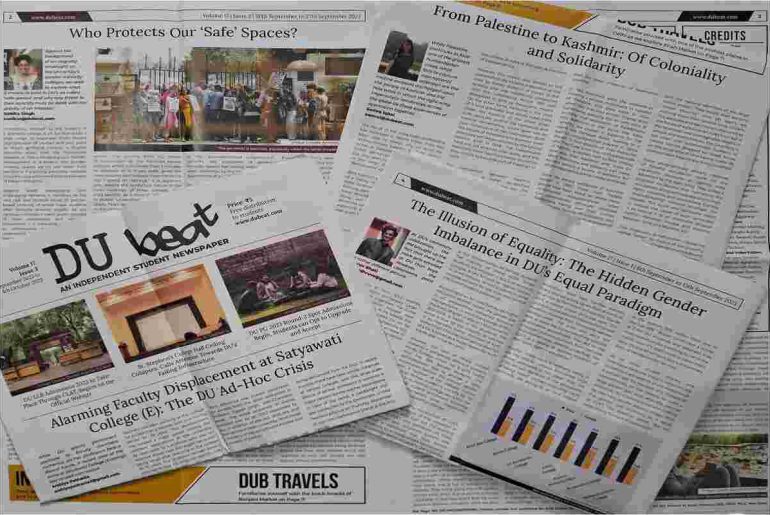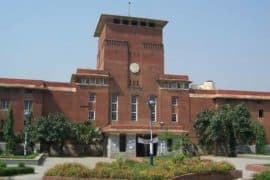While the media is preoccupied with playing ‘Antakshari’ on television or investigating how much money the PM placed in ‘daan peti’, student journalists are questioning the regime and discussing subjects that the media overlooks.
“The violence against journalists, the politically partisan media, and the concentration of media ownership all demonstrate that press freedom is in crisis in ‘the world’s largest democracy’, ruled since 2014 by Prime Minister Narendra Modi, the leader of the Bharatiya Janata Party (BJP) and the embodiment of the Hindu nationalist right,” reads the report by Reporters Without Borders, an international non-profit organisation that ranked India 161 out of 180 countries in the Press Freedom Index. The report focused on the decline and censorship of free media in India.
In recent years, there has been an increasing crackdown on independent media groups and journalists. While independent journalists pay a high price for what they do, others profit from propagating hatred and disinformation. Most national news channels in India are pro-government, who are busy spewing hatred against minorities and running prime-time shows about love stories while the north-eastern state of Manipur still continues to burn. All of this highlights the gruesome state of journalism in the country. However, a new ray of hope has emerged in recent years, attempting to resurrect Indian journalism from its ‘deathbed.’
Student journalism, which may be described as a new wave in modern journalism, acts as the lifeline of the country’s journalism industry. Student journalists are now the eyes and ears of the nation, using social media as a means to fight and discuss topics that the national media hides or ignores. This unrecognised group, which is frequently exposed to institutional controls, is doing far more than its capabilities to fulfil the country’s lack of free media. SPLC Executive Director, Hadar Harris, in conversation with The Jamia Review, said,
Student journalists play a key role in the civic life of their community. Not only do they report important issues of a school or school district, but as the number of professional journalists has dwindled, student journalists often also fill the gap in reporting on national, state, and regional issues.
These journalists rely heavily on digital media, with Instagram and Twitter being their primary means of connection with the public. However, many of these student media organisations have begun branching out into print media as well, publishing weekly or monthly issues with the support of sponsorships or donations.
At a time when national media is being bought and influenced by major political parties, we need a source of information that isn’t fabricated to cater to the majority. Independent and student media organisations work to guarantee that the voices of Dalits, Queers, Muslims, Tribals, and other marginalised communities are heard and discussed on a mainstream platform. Senior and established journalists and media outlets have greater freedom to report on such issues, but how effectively they use it is another matter. While the media is busy earning money by propagating hatred, these student journalists work on an unpaid basis due to a lack of sufficient funds or sources of income.
– Harshvardhan Bhaskar, Managing Editor, The Economic Transcript
While these student journalists are doing what a journalist does, they are often denied the democratic and legal rights associated with the press. Anshul Tewari, Founder, Youth Ki Awaaz, said,
There is a larger perception issue. We live in a culture that wants young people to be aware and educated, while simultaneously dismissing the expectations that arise as a result of that awareness. The main issue is that society undermines youth opinions and talent. This inevitably cultivates a viewpoint that does not recognise or consider the degree of journalism undertaken by the students, thereby disregarding the necessity for legal and democratic rights for such spaces.
However, this group is frequently exposed to harassment and legal abuse, not only from the government but also from their academic institutions. Recently, cases of students being suspended or harassed for writing critical of their college or regime are on the rise. In 2015, the principal of St. Stephens College banned an e-magazine and suspended its editor for failing to obtain permission for its content before its publication. This year, students from O.P. Jindal University were given suspensions for distributing a magazine that addressed problems affecting farmers and the working class.
Such harassment, along with the built-in risks associated with the field of journalism, makes it difficult for these groups to function and thrive. Public recognition is the essential foundation upon which these groups can grow and survive. Along with this, it is the responsibility of those in positions of power and established media organisations to assist in the sustainability of these spaces. Anonymous donations, organised business models and student media collaboration with independent media outlets can help them achieve recognition and resources to report freely and independently.
Read also: National Press Day: A Closer Look at Student Journalism
Featured image credits: Dhruv Bhati for DU Beat
Dhruv Bhati
[email protected]





Comments are closed.